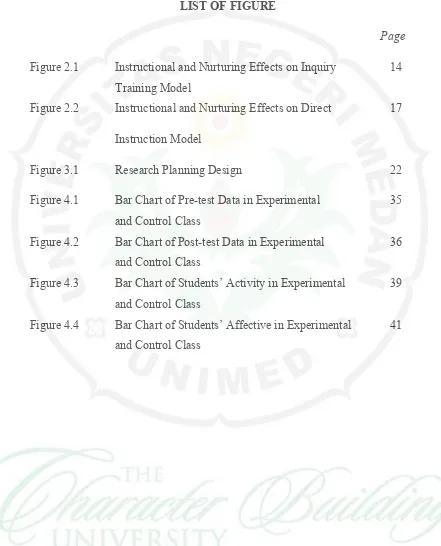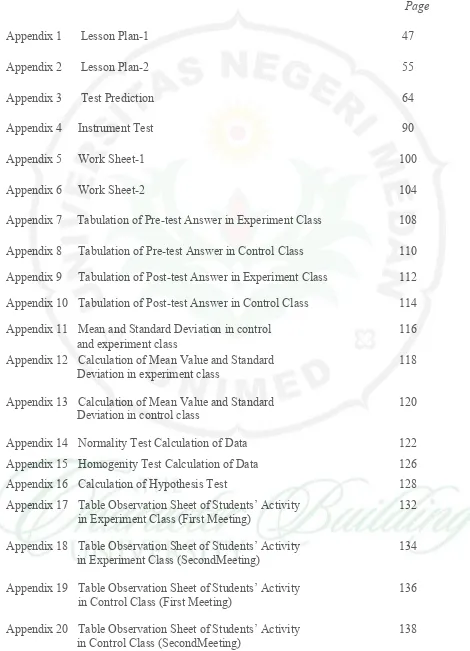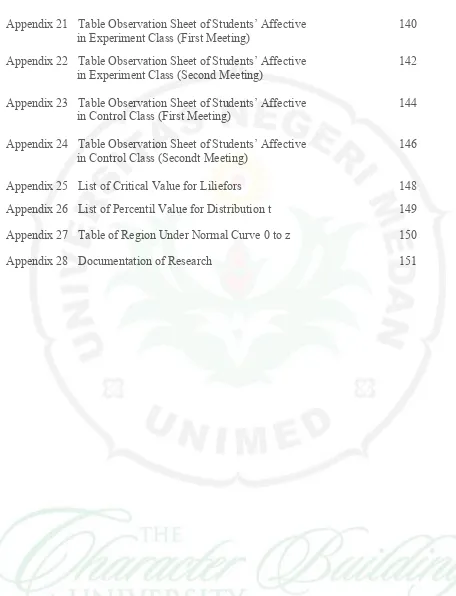BIOGRAPHY
PREFACE
The authors say the praise and gratitude to God Almighty, for all the graces and blessings that provide health and wisdom to the author that this study can be completed properly in accordance with the planned time.
Thesis entitled "The Difference of Students’ Learning Outcomes Using Inquiry Training Model and Direct Instruction Model in Light Topic at Class VIII SMP N 1 Tebing Tinggi ", prepared to obtain a Bachelor's degree Physical Education, Faculty of Mathematics and Natural Science in State University of Medan.
The Difference of Students’ Learning Outcomes Using Inquiry Training Model and Direct Instruction Model in Light Topic at Class VIII
SMP N 1 Tebing Tinggi
Agnesia M Damanik (Reg. Number 409322012)
ABSTRACT
vi
CONTENT
Page
Legitimating sheet i
Biography ii
Abstract iii
Preface iv
Content vi
List of Figure ix
List of Table x
List of Appendix xi
CHAPTER I 1
1.1 Background 1
1.2 Problem Identification 3
1.3 The Scope of Study 4
1.4 Problem Formulation 4
1.5 Objectives 4
1.6 Benefits 5
CHAPTER II 6
2.1 Theoretical Framework 6
2.1.1 Definitions of Learning 6
2.1.2 Learning Process 6
vii
2.1.4 Definitions of Learning Model 8
2.1.5 Inquiry Teaching/Learning Theory 8
2.1.6 Inquiry Training Model 10
2.1.6.1 Syntax of Inquiry Training Model 12
2.1.7 Direct Instruction 15
2.1.7.1 Goals and Assumptions 15
2.1.7.2 Syntax 15
2.2 Conceptual Framework 17
2.3 Hypothesis 18
CHAPTER III 19
3.1 Location and Time of Research 19
3.2 Population and Sample of Research 19
3.2.1 Population of Research 19
3.2.2 Sample of Research 19
3.3 The Research Variable 19
3.4 Type and Design of Research 19
3.4.1 Research Type 19
3.4.2 Research Design 20
3.5 The Research Procedure 20
3.6 Data Collection Technique 23
3.6.1 Pretest 23
3.6.2 Posttest 23
3.7 Research Instruments 23
viii
3.7.2 Observation Sheet 24
3.8 Data Analysis Technique 28
3.8.1 To Determine the Mean 29
3.8.2 To Determine the Mean and Standard Deviation 29
3.8.3 Normality Test 29
3.8.4 Homogeneity Test 30
3.8.5 Hypothesis Test 31
CHAPTER IV 34
4.1 Research Result 34
4.1.1 Students’ Learning Outcomes in Cognitive Domain 34
4.1.1.1 Pre-test Data of Experiment and Control Class 34
4.1.1.2. Post-test Data of Experimental and Control Class 35
4.1.2. Testing of Data Analysis 35
4.1.2.1 Normality Test 36
4.1.2.2. Homogeneity Test 36
4.1.2.3. Hypothesis Testing 37
4.1.3. Students’ Learning Outcomes in Psychomotor Domain 37
4.1.4. Students’ Learning Outcomes in Affective Domain 39
4.2. Discussion 40
CHAPTER V 45
5.1 Conclusion 45
5.2 Suggestion 45
x
LIST OF TABLE
Page Table 2.1 Syntax of Inquiry Training Model 14 Table 3.1 Two Group Pretest-Posttest Design 20 Table 3.2 Specifications achievement test in light topic 23 Table 3.3 Criterion of affective and psychomotor domain 24 Table 3.4 Observation of Students’ Activity in Control Class 25
(Psychomotor)
Table 3.5 Observation of Students’ Activity in 26 Experimental Class (Psychomotor)
Table 3.6 Observation of Students’ Affective in experiment class 27 Table 3.7 Observation of Students’ Affective in control class 28 Table 4.1 Pre-test of Experimental and Control Class 35 Table 4.2 Post-test of Experimental and Control Class 36 Table 4.3 Data Normality Test of Experimental 37
and Control Class
Table 4.4 Data Homogeneity Test of Experimental 37 and Control Class
ix
LIST OF FIGURE
Page Figure 2.1 Instructional and Nurturing Effects on Inquiry 14
Training Model
Figure 2.2 Instructional and Nurturing Effects on Direct 17 Instruction Model
Figure 3.1 Research Planning Design 22
Figure 4.1 Bar Chart of Pre-test Data in Experimental 35 and Control Class
Figure 4.2 Bar Chart of Post-test Data in Experimental 36 and Control Class
Figure 4.3 Bar Chart of Students’ Activity in Experimental 39 and Control Class
LIST OF APPENDIX
Page
Appendix 1 Lesson Plan-1 47
Appendix 2 Lesson Plan-2 55
Appendix 3 Test Prediction 64 Appendix 4 Instrument Test 90 Appendix 5 Work Sheet-1 100
Appendix 6 Work Sheet-2 104
Appendix 7 Tabulation of Pre-test Answer in Experiment Class 108
Appendix 8 Tabulation of Pre-test Answer in Control Class 110
Appendix 9 Tabulation of Post-test Answer in Experiment Class 112
Appendix 10 Tabulation of Post-test Answer in Control Class 114
Appendix 11 Mean and Standard Deviation in control 116
and experiment class Appendix 12 Calculation of Mean Value and Standard 118
Deviation in experiment class Appendix 13 Calculation of Mean Value and Standard 120
Deviation in control class Appendix 14 Normality Test Calculation of Data 122
Appendix 15 Homogenity Test Calculation of Data 126
Appendix 16 Calculation of Hypothesis Test 128
Appendix 17 Table Observation Sheet of Students’ Activity 132
in Experiment Class (First Meeting) Appendix 18 Table Observation Sheet of Students’ Activity 134
in Experiment Class (SecondMeeting) Appendix 19 Table Observation Sheet of Students’ Activity 136
in Control Class (First Meeting) Appendix 20 Table Observation Sheet of Students’ Activity 138
Appendix 21 Table Observation Sheet of Students’ Affective 140
in Experiment Class (First Meeting) Appendix 22 Table Observation Sheet of Students’ Affective 142
in Experiment Class (Second Meeting) Appendix 23 Table Observation Sheet of Students’ Affective 144
in Control Class (First Meeting) Appendix 24 Table Observation Sheet of Students’ Affective 146
in Control Class (Secondt Meeting) Appendix 25 List of Critical Value for Liliefors 148
Appendix 26 List of Percentil Value for Distribution t 149
Appendix 27 Table of Region Under Normal Curve 0 to z 150
CHAPTER I
INTRODUCTION
1.1 Background
Natural science is concerned with how to find out about natural
phenomenon systematically, so that the natural science is not just a collection of
knowledge mastery of facts, concepts, or only principles but also is a process of
discovery. Natural science education expected to become facilities for learners to
learn about human and environment, as well as the prospect of further
development in applying them in daily life. The process of learning places
emphasis on providing on experience to develop competence in order for learners
to explore and understand the natural surrounding scientifically.
Physics is one of the sciences that important in education. Studying of
physics can be proven with experiment in the laboratory or in the field.
Historically many experts when study of physics giving inventions and new
concepts are very useful for the development of human life. Experts try to learn
what happens in nature, understand concept, practice the same thing, practicing
the other possibilities of happening and poured it into a masterpiece. This works
in the development of technology that was donated has an effect on the increase of
human civilization.
During in time, physics is one of subjects that are less attractive to
students. It is evident from the low percentage of students' mastery learning. This
is because in addition to the material in these subjects is difficult to understand,
sometimes the delivery of content by teachers lacking attract students. In general,
physics teacher at school more often discussing the theory of the handbook,
providing formulas and provide example problems. This led to a physical science
reading material and students can only imagine.
Learning models like above causing physics to be one of the subjects
which are not interested by the students and paradigm of students who assumes
that physics is difficult. Though physics is a subject that is close to the daily life
teacher has an important role in instilling positive paradigm for students. So
physics is no longer a daunting subject and boring.
Based on preliminary study through the direct observation by
interviewing the physics teacher at SMP N 1 Tebing Tinggi suggests teachers tend
to still use the conventional learning with lecture and question and answer that is
teacher centered. In presenting the subject matter, the teacher explain to the class
and give a summary of the material with notes on the board and the students listen
and record the important things of the material being taught. This leads to students
not directly involved in the learning process and passive. From interviews said
also that the students learning outcomes in physics subject is low. When the value
of KKM 75, approximately 70% of students who did not complete the study in the
field of physics.
Many things can cause low physics student learning outcomes, one of
which is the learning process that is not in favor of the students. Student learning
is just as listeners and teachers are more instrumental or teacher-centered (teacher
centered). Dominance of teachers in this study led to more students waiting for a
dish of knowledge from the teacher rather than finding themselves the knowledge,
skills, and attitudes required in acquiring knowledge.
Based on the observation found that only about 50% students’ in SMP N
1 Tebing Tinggi which like the physics. This is because physics is a subject which
is interesting and challenging. Moreover, if the method of teaching the teacher is
very nice, it will make them more interested in learning physics. In their daily life,
they've responded well to the subjects of physics, this can be seen when teachers
teach, they observe and record things that are important.
From this observation also found that 38% of students prefer to learn
physics when practiced learning how to direct and 36% of students prefer to learn
physics by way of groups. But in reality teachers rarely engage students’ in the
process getting their knowledge and only emphasizes the students to memorize
formulas and does not emphasize on the concept and its application. In fact, many
students are still difficulties in using the formula to solve a given problem. During
the material being studied significantly. So in this case the student less directly
involved in the learning activity.
Based on the above conditions should apply an appropriate model of
learning and can improve students’ learning outcomes in physics. Learning model
that suitable for used is inquiry training model. Inquiry training model is designed
to bring students directly into scientific process into small periods of time. The
training has resulted in an increased understanding of science, more creative
thinking, and skills for obtaining and analyzing information as students establish
facts, build concepts, and then generate and test explanations or theories. The
students are active learners involved in exploration, questioning, problem solving,
inductive reasoning, invention, labeling, and discovery.
Researchers previously performed by Rostina Harahap (2009) obtained
an average value of 36.00 after a pretest that is treated with inquiry learning model
of training the student learning outcomes increased with an average value of
77.40, with the title "The Effect of Inquiry Training Model Toward Student
Learning Outcomes in Newton's law Topic at Class VIII SMP N 6 Academic Year
2009/2010 ". The weakness in this study is less able to take advantage of future
researchers in working together so that when collecting assignments, students rush
to do it. And students’ difficulties in the implementation of group work.
The background above shows that the issue is very important to
investigate and look for the solution, because if the problem is not resolved then it
is difficult for teachers to achieve the goals of learning and difficult for students to
achieve the competencies expected.
1.2 Problem Identification
Based on the background above can be identified some of issues, namely:
1. Paradigm of students who assumes that physics is difficult
2. Teachers still use conventional learning (teacher centered)
3. Students’ learning outcomes in physics subject is low
1.3 The Scope of study
As for the scope of study in this research are:
1. Research subject is students class VIII SMP N 1 Tebing Tinggi academic
year 2012/ 2013.
2. The topic will be learn is light by using inquiry training model in
experimental class
3. Learning outcomes will researched in cognitive, affective and
psychomotoric aspect
1.4 Problem Formulation
Based on the background above, problem identification and the scope of
study above, so the problem formulations in this research are:
1. How the average value of students’ learning outcomes of using inquiry
training model and direct instruction model in light topic at class VIII SMP
N 1 Tebing Tinggi?
2. How the students’ activity and students’ affective using inquiry training
model and direct instruction model in light topic at class VIII SMP N 1
Tebing Tinggi?
3. Is there significant difference of students’ learning outcomes using inquiry
training model and direct instructional model in light topic at class VIII
SMP N 1 Tebing Tinggi?
1.5 Objectives
Based on the problem formulation above so the objectives that will be
achieved in this research are:
1. To know the average value of students’ learning outcomes of using inquiry
training model and direct instruction model in light topic at class VIII SMP
N 1 Tebing Tinggi
2. To know the students’ activity and students’ affective using inquiry
training model and direct instruction model in light topic at class VIII SMP
3. To know the significant difference of students’ learning outcomes using
inquiry training model and direct instructional model in light topic at class
VIII SMP N 1 Tebing Tinggi
1.6 Benefits
1. For school : give good contribution to repair learning process and improve
the school quality through raising of student learning achievement and
teachers professionalism
2. For Teacher : as an input to choose appropriate method in physics learning
process
3. For student : students more active in learning process and students get
good value in physics subject
4. For researcher : as reference to implement learning process to be effective
CHAPTER V
CONCLUSION AND SUGGESTION
5.1 Conclusion
Based on the research result, data analysis, and discussion so can
be concluded that :
1. The average value of students’ learning outcomes of using inquiry
training model is higher than student who get direct instructional model.
2. Students’ activity as long as using inquiry training model increased, from
the first meeting up to the second meeting. The category of students’
activity is good. And students’ affective as long as using inquiry training
model also increased, from the first meeting up to the second meeting.
The category of students’ affective is good.
3. Based on the results of the analysis of data processing hypothesis testing
using the t test get that tcount > ttable, so it can be stated that there is a
significant difference of students’ learning outcomes using inquiry
training model and direct instructional model in light topic at class VIII
SMP N 1 Tebing Tinggi.
5.2 Suggestion
Based on research result and discussion before, researcher give
suggestions as follows :
1. For the next researcher so that use the time effectively thus the syntax
in inquiry training model can achieved and occurs well.
2. For the next researcher, so that prepare one observer for each of group
to get accurate data and to observe the students’ affective will be better
if researcher take daily notes of students from class teacher.
3. For the next researcher so that give more attention and guidance of
REFERENCES
Alberta. 2004.Focus on inquiry: a teacher’s guide to implementing inquiry-based learning. Learning and Teaching Resources Branch.
Arends, Richard, I., 1998. Learning to Teach (fourth edition). Singapore: McGraw-Hill International.
Agbarachi, Jacinta, et all. 2011. Instructional Method and the School Science Currículum. Current Research Journal of Social Sciences , 3(3), 188-198.
Dahar, R., W., 2006. Teori-Teori Belajar dan Pembelajaran. Jakarta: Penerbit Erlangga.
Joyce, Bruce and Weil, Marsha. 1972. Models of Teaching. New Jersey: Prentice-Hall International, Inc.
Joyce, Bruce. 2004. Models of Teaching (fifth edition). New Jersey: Prentice-Hall International, Inc.
Klein, Stephen, B., 1991. Learning (Second Edition). Singapore :McGraw-Hill, Inc.
Sanjaya, W., 2006. Kurikulum Pembelajaran Teori dan Praktik Pengembangan KTSP, Jakarta; Kencana.
Pandey, A., et all. 2011. Effectiveness of Inquiry Training Model over Conventional Teaching Method on Academic Achievement of Science Students in India. Journal of Innovative Research in Education, 1(1), 7-20.
Sagala, Syaiful. 2003. Konsep dan Makna Pembelajaran, Bandung; Alfabeta.
Slavin, Robert E., 2006. Educational Psychology: theory and practice (Eight edition). USA: John Hapkins University.
Sudjana. 2005. Metoda Statistika. Bandung: Tarsito.
Usumartina. 2012. Perbedaan Model Pembelajaran Generatif dan Konvensional Terhadap Hasil Belajar Siswa Pada Sub Bab Materi Tekanan pada Zat Cair di SMPN 2 Tanjung Pura T. P 2011/2012. Skripsi. FMIPA: Unimed.


